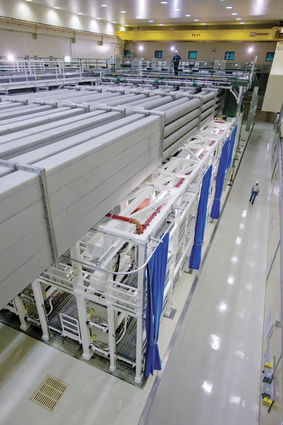Lab-sponsored seminar on future of nuclear energy highlights annual AAAS symposium in San Diego
Advanced nuclear energy concepts for a safe, sustainable and carbon-free future is one of many highlighted seminars presented by Lawrence Livermore National Laboratory, at the 2010 conference of the American Association for the Advancement of Science (AAAS).
This year’s conference, Feb. 18-22, at the San Diego Convention Center, is titled Bridging Science and Society, which mirrors one of LLNL’s key missions to enhance the energy and environmental security of the United States as well as strengthen the nation’s economic competitiveness.
Throughout the five-day conference, assorted Lab scientists will speak on topics of national interest, from future sources of clean, renewable energy to better analytical tools to counter terrorism.
Tomás Díaz de la Rubia, the Laboratory’s Chief Research and Development Officer and acting principal associate director for the Science and Technology Directorate, has organized "Advanced Nuclear Energy Concepts for a Safe, Sustainable, Carbon-Free Future" on Sunday, Feb. 21. Speakers include the High Commissioner of the French Commissariat a l’Énergie Atomique (CEA), Catherine Cesarsky, as well as the Chairman of the Japan Atomic Energy Commission (JAEC), Shunsuke Kondo.
Additional speakers who will discuss advanced nuclear energy concepts include the Lab’s Edward Moses, director of the National Ignition Facility (NIF), whose topic is "Laser Inertial Fusion Energy." Moses will discuss fusion as a potential source of clean, limitless energy. Moderating the session and the roundtable discussion will be Richard Meserve, former chairman of the U.S. Nuclear Regulatory Commission.
"This is an international perspective on the future of the nuclear fuel cycle," Díaz de la Rubia said. "Nuclear power holds the promise to help close the gap between the global supply and demand for clean, sustainable energy. However, in order to alleviate the myriad concerns that both policymakers and the public have, game-changing, disruptive new technologies that mitigate concerns related to safety, sustainability, long-term nuclear waste disposal and nuclear proliferation will be required."
While such approaches are currently being proposed, they have not yet been discussed in great detail in scientific and public policy forums, Díaz de la Rubia added. This symposium provides a series of technical presentations where these ideas will be discussed, followed by a panel discussion with global energy and nuclear power experts who will provide the pros and cons of the various ideas and the path forward for development, implementation and deployment.
LLNL’s Principal Associate Director at Large, Jane Long, is the organizer of a session entitled "Societal Strategies for Addressing the Climate and Energy Challenge," on Saturday, Feb. 20. NIF’s Edward Moses is scheduled to discuss "Is There Fusion in Our Future?" Moses will discuss the progress on NIF, the world’s largest and most energetic laser. NIF is expected to be the first laser to achieve fusion, the same force that powers the sun and the stars, in a laboratory setting.
The Lab’s Chris Ebbers is the organizer and moderator of a seminar Sunday, Feb. 21, that examines "Next Generation of Extreme Optical Tools and Applications." Speakers include LLNL’s Chris Barty on the topic "Revolutionizing Isotope Science and Applications with Laser-Like Gamma Rays."
International outreach is the subject of a session on Saturday, in which LLNL’s William Dunlop will look back at "The U.S. – China Lab-to-Lab Program of the 90s." Dunlop will recall high-level visits by scientists from LLNL and Los Alamos National Lab to the Chinese test site at Lop Nor, as well as the U.S. refusal to allow a reciprocal Chinese visit to the Nevada Test Site after the Tiananmen Square protest.
Another Saturday session is entitled "Real Numbers: Mathematical Technologies for Counterterrorism and Border Security." LLNL expert James Brase will discuss "Large Scale Network Analysis for Counterterrorism."
A session on nuclear forensics on Friday, Feb. 19, features LLNL’s Ian Hutcheon, whose presentation is entitled "Analytical Challenges in Detecting Undeclared Nuclear Activities."
Edward Moses returns on Sunday at a seminar on the history and future of laser technology, "Lasers at the Extreme: Ultra-Cold, Ultra-Fast, and Ultra-Hot Uses" at which he will discuss "National Ignition Facility: Creating Star Power in the Laboratory."
LLNL also will be showcasing NIF with a booth in the AAAS exhibit area. NIF will be represented at the AAAS Family Day weekend festivities, which are open to the general public free of charge, and feature demonstrations and hands-on exhibits.
Founded in 1952, Lawrence Livermore National Laboratory (www.llnl.gov) is a national security laboratory that develops science and engineering technology and provides innovative solutions to our nation's most important challenges. Lawrence Livermore National Laboratory is managed by Lawrence Livermore National Security, LLC for the U.S. Department of Energy's National Nuclear Security Administration.
Contact
Lynda Seaver[email protected]
925-423-3103
Related Links
2010 AAAS Annual MeetingNational Ignition Facility
Report on U.S.-China collaboration on carbon capture and sequestration
Identifying the Source of Stolen Nuclear Materials






